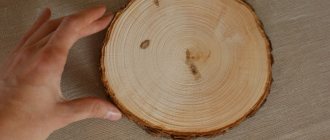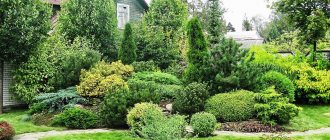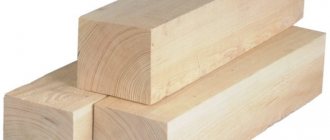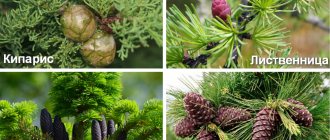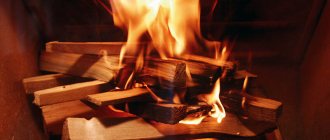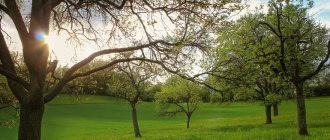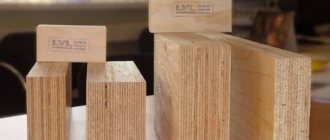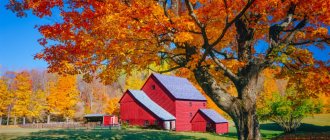Appearance of black alder wood
Description of black alder: the tree can have one or more trunks, and its height is from 20 to 25 meters. The span of an average tree can reach almost a meter. Black alder bark has a rich brown color. Over time, the trunk darkens almost to black.
The leaves of the tree are fleshy, toothed, and folds form on the leaf blades. The branches of black alder are evenly distributed along the trunk, and the crown has a rounded shape. It reaches almost 15 meters in diameter.
Black alder blooms in the spring months and has unisexual male and female flowers. When ripe, the seeds remain in the cones and begin to be sown only in March.
A characteristic feature of European alder: the leaves remain green all the time, even during leaf fall they do not acquire a yellow tint. The foliage of the plant contains a lot of nitrogen, so fallen alder leaves can even be used as fertilizer.
The young cone is initially light green, but after ripening in September or October it acquires a brown tint. Such cones hang on the branches throughout the winter months, and only after the weather warms up in March do they “spit out” the seeds. The seeds are carried by the wind or fall to the ground and are washed away when the snow melts with water.
The tree grows in swampy ponds and fields, sometimes forming entire alder forests. Distribution area: America, Europe, Baltic countries, Caucasus.
There are many beliefs associated with this plant, because the cut wood turns red instead of white. Superstitious people believed that it was blood coming out on the alder tree. This is precisely why the spread of sticky alder wood as amulets is connected. Tree branches can repel insects in the house, and things built from it are durable and do not rot for a long time.
Use of black alder in medicine
Bark. Infusion and tincture are an astringent and anti-inflammatory agent for enteritis and colitis. A decoction is a hemostatic for inflammation and bleeding from the intestines, for rinsing - for throat diseases, poultices - for ulcers and wounds, as a diaphoretic, for diarrhea. The powder is an anti-cancer agent, the decoction is for throat tumors.
Leaves. Alglutin alcohol extract is recommended as a laxative for chronic constipation.
Infusion - as an anti-inflammatory and astringent for diseases of the throat and intestines; as a diaphoretic for colds and coughs; wound healing; for rheumatism and gout. Decoction - for cancer of the breast, pylorus of the stomach, pancreas, duodenum, esophagus, rectum, throat, tongue, uterus and other tumors. Foot baths relieve the feeling of fatigue during long treks.
Infructescence (“cones”). Tincture, infusion (especially summer, green “cones”), liquid and dry extracts (“Tkhmelini”) - for acute and chronic enteritis and colitis, dysentery, colds, cough, gout; for gargling, mouthwash, to strengthen gums and diaphoretic in the form of tea. Included in the gastric collection.
Natural conditions
A moist substrate is best suited for it, but not oversaturated with moisture. Usually the tree can be found near lakes, rivers, and in places with well-drained soil. It is also possible for alder to grow in a swamp.
In areas where there are predominantly clay or rocky slopes, black alder does not grow tall. Growing in a certain area, it enriches the soil with nitrogen. This plant loves sunlight and does not freeze in frosts.
In Russian conditions, the tree can be found in almost every region of the country, except the Far North. It can even grow in sand, but the lifespan of the tree is reduced.
Medicines, method of use of black alder and dose
- Tincture of alder fruit (Tinctura fructuum Alni) is taken 25 drops 3 times a day.
- Dry extract of alder fruit (Extractum fructuum Alni siccum) is taken 0.5-0.6 g 3-6 times a day.
- Infusion of alder fruits ("cones") (Infusum fructuum Alni): 10 g (2 tablespoons) of raw materials are placed in an enamel bowl, pour 200 ml. hot boiled water, cover with a lid and heat in boiling water (in a water bath) for 15 minutes, cool at room temperature for 45 minutes, filter, squeeze out the remaining raw materials. The volume of the resulting infusion is adjusted to 200 ml with boiled water. The prepared infusion is stored in a cool place for no more than 2 days. Take 1/3-1/2 cup 2-3 times a day for 30 minutes. before meals as an astringent.
- Decoction of alder fruits: 15 g of raw material is poured into 200 ml. boiling water, boil for 15 minutes, then filter. Take 1 tablespoon 2-3 times a day.
- Infusion of alder bark: 15 g of raw material is poured into 200 ml. boiling water, leave in a warm place for 30 minutes, then filter. Take a tablespoon 3-4 times a day.
- Recipes for using alder in collections
Contraindications and possible side effects of black alder
Increased blood clotting.
Growing in the garden
The best soil for European alder is a slightly acidic fertile substrate that is well moistened. Despite the fact that the plant rarely freezes, in the first year it is better to prepare it for the winter by covering it with pine paws or straw. The same goes for gray alder.
If you decide to plant it in the garden, then you need a well-lit area. But if there is no such place, then European alder can be planted in partial shade.
But it is not recommended to give it an area where the wind often blows. A characteristic feature of black alder is its shallow root system. Therefore, young seedlings can simply fall to the ground. Seedlings are not planted close; there should be a decent interval between them. It is also not recommended to plant the tree in the shade, because it will quickly dry out and die.
This variety of alder is not considered capricious. Growing it in a garden plot is no more difficult than an ordinary fruit tree. A young seedling can be dug up in the forest or bought in a store.
Before planting a seedling in the ground, its root system is renewed and overgrown shoots are cut off. Before planting, only a trunk no higher than 80 cm should remain. In the first few months, the tree should be looked after more carefully. As it grows, it will strengthen itself and will not cause much trouble.
At this stage, it is important to water the tree in a timely manner, if there is little rainfall in the summer, and to fertilize it. This type of care is only necessary for the first couple of years. After this, all manipulations are reduced to pruning dry broken branches and watering during drought. In suitable conditions, black alder can live for about a hundred years. But there is official information about trees of this variety, which have reached an age of about three centuries.
General information
Alder wood is used very widely, and not only on its own. Thus, its shavings, as an antiseptic with astringent properties, are added to a mixture of beech, spruce and pine shavings, from which particle boards, plywood, and veneer are produced.
There are several common varieties of alder, the wood of each of which has its own set of qualities, pros and cons:
- Black alder. It is characterized as the most sensitive among its “brothers” to temperature changes, therefore it is not recommended for finishing saunas and baths. Wood is not very resistant to damage. It is often affected by fungal diseases, so it requires etching before use, and then good protection from moisture. Among the advantages, one can identify that it is more durable than other types of alder and has a more beautiful wood appearance. It is also integral in the manufacture of toys, for fuel, and even for the production of paper.
- Gray alder tolerates excess moisture better. A positive point is the fact that it can be used in the manufacture of a wide variety of products, containers, crafts, and environmentally friendly toys. It is often used to make shoes and various turning tools.
Diseases and pests
Black alder is susceptible to infection by fungal infections and insects. The natural immunity of the tree does not allow it to cope with them on its own. Treatment for fungal infections is carried out using fungicides, and insects are eliminated with insecticides.
The most dangerous enemies of sticky alder are butterflies and leaf beetles, which damage its foliage and lay eggs under the bark. These insects can be controlled with traps. If the main goal is to collect environmentally friendly raw materials, then it is recommended to treat the tree using folk remedies that do not contain chemicals.
Collection of raw materials
Harvesting of European alder cones begins from the last month of autumn to March. In March, the cones open on their own, so it will no longer be possible to prepare them. They will simply lose all the seeds. To collect plant materials, you need to carefully trim the ends of the branches with cones with pruning shears. After this, the cones are removed from the cut branches. Those fruits that have already fallen from the branches to the ground cannot be used.
The collected cones must be dried on a flat surface. The room for drying collected raw materials should be well ventilated. This could be a porch, a covered shed, or an attic.
On warm days, when there is no snow or rain, it is possible to listen to the buds in the fresh air. But it is necessary to turn over the collected raw materials from time to time. Once the buds have dried, they can be used for about three years.
Short description
Black alder grows up to 30-35 meters, the trunk diameter can reach 90 cm. In wetlands, a clump form is not uncommon, when several powerful trunks grow from one point. The branches grow at a large angle to the trunk, sometimes perpendicular. The crown is oval or pyramidal; over time, large branches are overgrown with small ones, and the crown becomes rounded.
Black alder, like gray alder, grows quite quickly, especially up to 5-10 years, and lives up to 100 years. Rarely there are specimens that have lived up to 300 years. This alder, unlike the gray species, does not have root suckers, but its root system is superficial, and also with nodules in which nitrogen-fixing bacteria live.
The bark of young alder is greenish-brown, with numerous light lenticels located across the trunk. With age it darkens, becomes black and becomes covered with cracks.
The leaves are round, most often with a notch at the top, and are located alternately on the branch. Dark green in color, with jagged edges, do not turn yellow in autumn, turning brown after falling. Young leaves are covered with a sticky substance that attracts insects.
The tree is monoecious, blooms in early spring. Male flowers are drooping catkins, while female flowers are oval on long petioles. Male flowers begin to form in the fall, and female flowers in the spring. Pollination occurs due to the wind, when there are no leaves on the tree yet, and nothing interferes with the process.
By autumn, the fruits, or oval cones about 2 cm long, ripen; in summer they are green, but in autumn they turn black. They contain nuts with a wing inside. They can be collected in the fall, but the tree itself releases the seeds into free flight only in the spring, and they are carried by wind and water.
Fruits appear annually, but not earlier than 10 years of age. Specimens growing in the forest begin to bear fruit at 30 years of age.
Areas of application
This plant is used in the construction industry, for the production of furniture and lining. All parts of the plant are used in industry, from the root system to the foliage.
In health care
It contains a large amount of tannins, especially in the buds and bark of the plant. Decoctions and infusions of them can be used to treat inflammatory diseases, as a hemostatic agent for bleeding.
They improve well-being with sore throats and relieve swelling. Due to the antibacterial effect, plant raw materials are used to disinfect wounds on the skin and for pathologies of the gastrointestinal tract. Alder decoctions help relieve pain and spasms.
In the textile sector
In the textile industry, extracts from catkins and plant bark are used to obtain dyes. They help color leather, fabric and wool in black, red and yellow shades.
Construction, furniture production
Due to the rapid growth of the tree, they are often replanted in cleared forest plots. Plants are also used to heat the room. Sticky alder is considered soft and turns pinkish when cut.
If you treat wood in conditions of high humidity, it becomes durable and rots little. Therefore, it can be used for the foundations of buildings that go under water, for hydraulic structures and wells. If the tree grows in a humid environment, these properties are enhanced.
Other Applications
Sticky aspen pollen is used to feed fish. It is possible to enrich food for pets and livestock with the help of dried leaves and young twigs. Beekeepers take flower pollen to feed the bees until the main honey plants have yet bloomed. Pollen and resin are subsequently processed into propolis.
Contraindications
Black alder is not toxic, but, like any folk remedy, it should be used only after consultation with your doctor. It is recommended to discuss the duration of treatment and dosage with your doctor. Otherwise, you can harm the body.
Infusions and decoctions of sticky alder should not be drunk while pregnant or while breastfeeding. It should be used with extreme caution by people who have diagnosed kidney and liver pathologies.
Currently reading:
- Application and propagation of frost-resistant gray alder
- How to grow Chinese cabbage in open ground
- Using hydrogel in open ground for plants
- Increased potato yield using Dutch technology
Share the news on social networks
About the author: Lyudmila Vasilievna Nosikova
Agronomist of the state agricultural enterprise "Garovskoe" of the Khabarovsk region of the Khabarovsk Territory.
Alder
Alder is the wood of various species of trees from the genus Alder (known botanically as Alnus). In Europe, in carpentry production, they mainly use solid black alder, and less often - gray alder.
The natural distribution area of black alder is almost throughout Europe to the Caucasus and even Siberia. It does not grow in the steppes of southern European Russia, southern Spain, or central Scandinavia. Alder also grows in North Africa and Western Asia. The natural range of gray alder is smaller, it is not found in the south and west of Europe, but it extends further to the north and east than black alder.
The most common types of alder in wooden interior decoration are black alder, also known as sticky alder (Alnus glutinosa) and gray (white) alder (Anus incana). These two breeds grow in the European part of the countries of the former USSR and in Western Siberia. Alder is a kernel-free species. That is, the core and sapwood do not differ in color. The wood is reddish-white, reddish-yellow to light red-brown, and quickly darkens when exposed to light. It has excellent resistance to water. Alder wood is light, soft and, at the same time, viscous. It cuts perfectly, does not prick when carving, the alder material is not brittle, it does not crack when dried. Alder is viscous and malleable to processing in any direction, which is why it is often used in critical products, for example in the production of musical instruments.
Immediately after cutting, white alder, i.e. common alder (and in general there are about 15 species of alder growing in Russia) quickly turns yellow, may even acquire an orange tint, but then this bright yellow color turns gray, only the end remains yellow. It is due to oxidation that it acquires a bright orange-red color, but when dried, this color disappears. Dried alder wood inside the split and in the cut is also not at all bright yellow in color, but after processing, under oil or, for example, drying oil, it again acquires, although not as bright as when cut fresh, but still a very intense and uniform color , how alder differs from other types of wood used in wood finishing.
Alder wood has a large number of thin fibers located along the pores. Wood rays are not very pronounced. However, sometimes the tree rays are connected in lines and then they are more visible. The boundaries of the growth rings are not clearly visible, but on late wood (it is less porous and denser) the growth rings are clearly visible. There are often color spots on alder wood.
A negative property of the species is that alder does not drill well, perhaps worse than all other finishing species. Another point is that the array sometimes contains core repetitions - longitudinal brown lines, sometimes even wide formations.
In the sun, alder wood loses its rich orange hue in a couple of months, becoming somewhat similar to pine wood. White alder is a little lighter and, by the way, stronger than the yellow-red wood of black alder. Gray alder wood has finer fibers and is more shiny.
The density of the rock is about 420 - 640 kg/m3. Alder wood is soft and has a fairly uniform, refined structure. Alder wood is fragile and inelastic; these qualities are similar to linden wood. Alder is not resistant to rotting during outdoor construction or when in contact with the ground, but under water it shows resistance at the level of oak. Alder dries well without a tendency to warp or crack, and is easy to process. Attaches well with screws and glue, but is prone to splitting when driving nails. When wet contact with iron, gray spots appear on the wood, and the iron elements rust. Solid alder also deteriorates when interacting with cement. Otherwise, no problems arise. In general, the differences between the physical and mechanical properties of black and gray alder solid wood are small. Black alder is somewhat heavier and warps less than gray alder. But still, gray alder is used less often, since trees of this alder variety rarely grow of sufficient size and, moreover, often have a crooked trunk. This tree usually grows in the required proportions only in the Baltic states and Finland.
Alder is used to produce veneer, plywood and chipboard. Alder is a wonderful material for the production of internal parts of wooden furniture and finishing of wooden interiors. Because of its ability to perfectly accept stain, alder is used to imitate more valuable types of wood, such as cherry, mahogany, ebony, and walnut. Alder carpentry will fit perfectly into the interior of your home library or office, kitchen or hallway, allowing you to create an elite-level interior while spending less money. Alder is excellent for making solid wood doors, furniture facades, arches and portals, and even tables. Alder is also used for furniture restoration.

